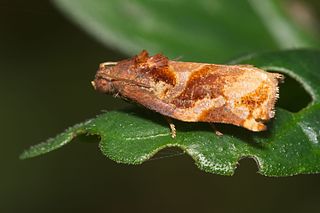
Homona is a genus of moths belonging to the subfamily Tortricinae of the family Tortricidae.

Homona coffearia, the tea tortrix or camellia tortrix, is a moth of the family Tortricidae. The species was first described by Nietner in 1861. It is widely distributed in the Oriental region.

Homona mermerodes is a species of moth of the family Tortricidae first described by Edward Meyrick in 1910. It was described from the Solomon Islands, but is also found in Australia (Queensland), New Guinea and Seram. The habitat consists of bamboo, secondary forests and alluvial forests.
Homona baolocana is a species of moth of the family Tortricidae. It is found in Vietnam.
Homona parvanima is a species of moth of the family Tortricidae. It is found in Vietnam.
Homona difficilis is a species of moth of the family Tortricidae. It is found in Vietnam and on Borneo.

Homona magnanima, the Oriental tea tortrix moth, is a species of moth of the family Tortricidae. It is found in Japan, Taiwan, China and Vietnam.
Homona aestivana is a species of moth of the family Tortricidae first described by Francis Walker in 1866. It is found in the Philippines, Australia (Queensland), New Guinea and Indonesia.
Homona salaconis is a species of moth of the family Tortricidae first described by Edward Meyrick in 1912. It is found in the Philippines, Seram, Sumatra, Sulawesi and Dutch New Guinea. The habitat consists of cultivated areas and lowland forests.
Homona antitona is a species of moth of the family Tortricidae first described by Edward Meyrick in 1927. It is found on Sumatra and Seram in Indonesia. The habitat consists of secondary upper montane forests.
Homona obtusuncus is a species of moth of the family Tortricidae first described by Józef Razowski in 2013. It is found on Seram Island in Indonesia. The habitat consists of lower montane forests.
Homona privigena is a species of moth of the family Tortricidae first described by Józef Razowski in 2013. It is found on Seram Island in Indonesia. The habitat consists of upper montane forests.
Homona blaiki is a species of moth of the family Tortricidae first described by Józef Razowski in 2013. It is found on Seram and in New Caledonia. The habitat consists of alluvial forests, Eucalyptus forests, bamboo and secondary forests.
Homona fatalis is a species of moth of the family Tortricidae first described by Edward Meyrick in 1936. It is found on Seram and in Malaysia. The habitat consists of cultivated areas, lowland forests, bamboo and secondary forests.
Homona auriga is a species of moth of the family Tortricidae. It is found on New Guinea, where it has been recorded from Papua, Indonesia.
Homona bakeri is a species of moth of the family Tortricidae. It is found in the Philippines on the island of Luzon.
Homona bicornis is a species of moth of the family Tortricidae. It is found in the Philippines on the island of Luzon.
Homona eductana is a species of moth of the family Tortricidae. It is found in India, Thailand, Malaysia, Singapore and China.
Homona encausta is a species of moth of the family Tortricidae first described by Edward Meyrick in 1907. It is found in Sri Lanka, Luzon in the Philippines and Vietnam.
Homona saclava is a species of moth of the family Tortricidae. It is found in Madagascar.



